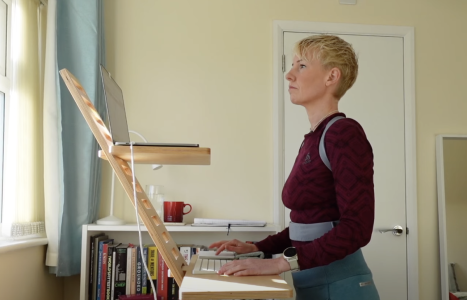Small movements, big impact: The heart health benefits of standing up
By
Veronica E.
- Replies 0
Disclaimer: The information provided in this article is for educational purposes only and is not intended as a substitute for professional medical advice, diagnosis, or treatment. Always consult your physician or other qualified healthcare providers with any questions you may have regarding a medical condition or before making any changes to your health regimen.
We’ve all heard that staying active is good for the heart, but what if one of the simplest ways to help your cardiovascular health didn’t involve formal workouts at all?
New research shows that just standing up more often during the day—no special equipment, gym membership, or sweatbands required—may provide measurable benefits.
For people, especially women over 60, this small change could have an impact on blood pressure, a major risk factor for heart disease and stroke.
And unlike intense exercise programs, this habit is easy to weave into everyday routines.
The best part? You can start right now, right where you are.

A simple habit with surprising effects
A study published in Circulation examined whether increasing “sit-to-stand” transitions could benefit heart health in postmenopausal women.
Researchers, led by Dr. Sheri Hartman at the University of California-San Diego, found that women who stood up from a seated position more often each day saw meaningful improvements in their blood pressure after just three months.
Importantly, these changes occurred without adding extra exercise—simply interrupting long periods of sitting with frequent standing made the difference.
Also read: Walking 7,000 steps a day may be healthier than you think, study shows
Inside the study
More than 400 postmenopausal women, all overweight or obese with an average age of nearly 68, took part.
They were divided into three groups:
All participants received healthy aging coaching, but only the “stand more” group was encouraged to rise from their seats frequently.
On average, this group added 26 more daily stand-ups than the control group.
Also read: Cardiologist warns this lifestyle habit is as deadly as smoking—what is it?
Notable results
After three months, the “stand more” group recorded average drops of more than 3 mm/Hg in systolic blood pressure and over 2 mm/Hg in diastolic pressure.
While the changes were not statistically significant, researchers considered them promising—especially given the strong link between high blood pressure and heart disease.
The group that only reduced total sitting time saw no similar benefit, suggesting the act of standing up itself may be key.
Also read: Is your daily sitting canceling out your exercise efforts? Avoid the hidden risks of too much sitting!
Why standing helps
Extended sitting slows circulation and relaxes muscles, reducing the body’s efficiency in processing blood sugar and fats.
Standing activates leg muscles, boosts blood flow, and gives the cardiovascular system a gentle push to keep things moving—like a quick, mini workout repeated throughout the day.
Also read: Are you missing this 30-minute daily habit that could cut your risk of sudden cardiac death in half?
Making it a daily habit
You don’t need special gear to stand more often:
As study co-author Dr. Andrea LaCroix explained, “With a little coaching, we can teach ourselves to sit less and it makes a tangible difference to our short- and long-term health.”
Also read: Could your air filter help lower blood pressure? Study says yes
Beyond blood pressure
Other research shows that breaking up sitting time may reduce the risk of type 2 diabetes, improve balance and mobility, ease joint stiffness, and boost mood and energy levels.
Over time, this small habit may also help older adults maintain independence.
The research team plans longer follow-up studies to see if benefits grow over time.
But for now, there’s little downside to adding more standing moments to your day.
Read next: Could this simple diet trick lower your blood pressure—even if you have diabetes?

Have you tried standing up more regularly? Have you noticed changes in your energy or health? Share your tips and experiences so others can be inspired to rise—literally—for better health!
We’ve all heard that staying active is good for the heart, but what if one of the simplest ways to help your cardiovascular health didn’t involve formal workouts at all?
New research shows that just standing up more often during the day—no special equipment, gym membership, or sweatbands required—may provide measurable benefits.
For people, especially women over 60, this small change could have an impact on blood pressure, a major risk factor for heart disease and stroke.
And unlike intense exercise programs, this habit is easy to weave into everyday routines.
The best part? You can start right now, right where you are.

Taking regular standing breaks during the day may offer heart health benefits for older adults. Image Source: YouTube / Laura Try.
A simple habit with surprising effects
A study published in Circulation examined whether increasing “sit-to-stand” transitions could benefit heart health in postmenopausal women.
Researchers, led by Dr. Sheri Hartman at the University of California-San Diego, found that women who stood up from a seated position more often each day saw meaningful improvements in their blood pressure after just three months.
Importantly, these changes occurred without adding extra exercise—simply interrupting long periods of sitting with frequent standing made the difference.
Also read: Walking 7,000 steps a day may be healthier than you think, study shows
Inside the study
More than 400 postmenopausal women, all overweight or obese with an average age of nearly 68, took part.
They were divided into three groups:
- One group aimed to reduce total sitting time.
- One group focused on increasing daily sit-to-stand transitions.
- A control group maintained their usual habits.
All participants received healthy aging coaching, but only the “stand more” group was encouraged to rise from their seats frequently.
On average, this group added 26 more daily stand-ups than the control group.
Also read: Cardiologist warns this lifestyle habit is as deadly as smoking—what is it?
Notable results
After three months, the “stand more” group recorded average drops of more than 3 mm/Hg in systolic blood pressure and over 2 mm/Hg in diastolic pressure.
While the changes were not statistically significant, researchers considered them promising—especially given the strong link between high blood pressure and heart disease.
The group that only reduced total sitting time saw no similar benefit, suggesting the act of standing up itself may be key.
Also read: Is your daily sitting canceling out your exercise efforts? Avoid the hidden risks of too much sitting!
Why standing helps
Extended sitting slows circulation and relaxes muscles, reducing the body’s efficiency in processing blood sugar and fats.
Standing activates leg muscles, boosts blood flow, and gives the cardiovascular system a gentle push to keep things moving—like a quick, mini workout repeated throughout the day.
Also read: Are you missing this 30-minute daily habit that could cut your risk of sudden cardiac death in half?
Making it a daily habit
You don’t need special gear to stand more often:
- Set reminders — Stand up and stretch every 30 minutes.
- Pair with daily tasks — Take calls or read the mail while standing.
- Add visual cues — Sticky notes on remotes or screens can remind you to get up.
- Make it social — Challenge a friend or family member to a daily stand-up count.
As study co-author Dr. Andrea LaCroix explained, “With a little coaching, we can teach ourselves to sit less and it makes a tangible difference to our short- and long-term health.”
Also read: Could your air filter help lower blood pressure? Study says yes
Beyond blood pressure
Other research shows that breaking up sitting time may reduce the risk of type 2 diabetes, improve balance and mobility, ease joint stiffness, and boost mood and energy levels.
Over time, this small habit may also help older adults maintain independence.
The research team plans longer follow-up studies to see if benefits grow over time.
But for now, there’s little downside to adding more standing moments to your day.
Read next: Could this simple diet trick lower your blood pressure—even if you have diabetes?
Key Takeaways
- Postmenopausal women in a new study who increased sit-to-stand movements by about 26 times per day saw drops in systolic and diastolic blood pressure over three months.
- These benefits appeared without adding extra exercise; the key change was breaking up sitting with frequent standing.
- Reducing total sitting time without focusing on standing frequency did not produce the same results.
- Researchers plan longer studies to examine the long-term heart health effects of this habit.
Have you tried standing up more regularly? Have you noticed changes in your energy or health? Share your tips and experiences so others can be inspired to rise—literally—for better health!






